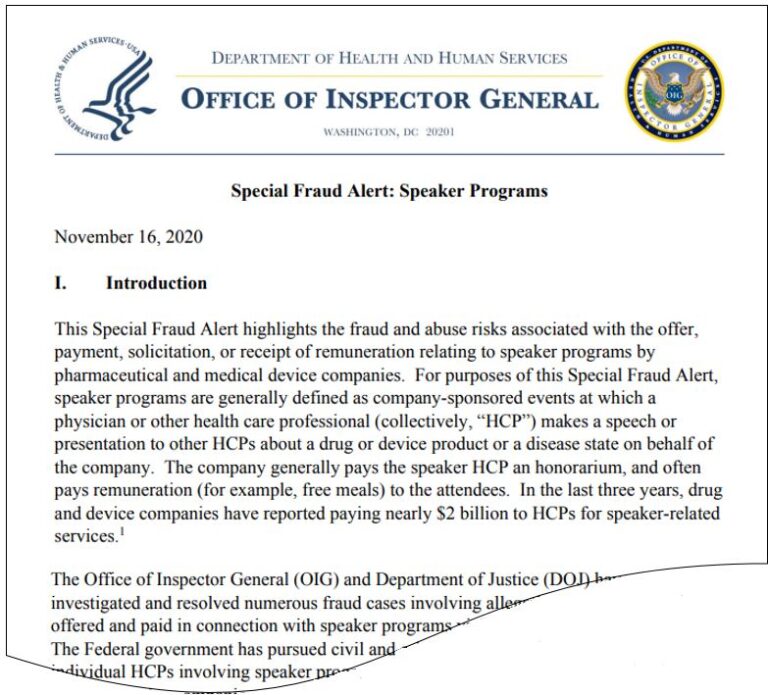Article • December 8, 2020
Government scrutiny of biopharma peer-to-peer, or speaker programs, is rising…Here’s what to do about it.

Speaker programs are a common tactic of most biopharma companies’ peer-to-peer education efforts. The Office of Inspector General (OIG) in the US Department of Health and Human Services refers to speaker programs as marketing “presentations” or “speeches” that pose, “fraud and abuse risks,” for which the OIG is, “skeptical about their educational value.” As a recent Fraud Alert indicates, OIG is ramping up its scrutiny of these programs. This article shares several steps biopharma companies can take to demonstrate that their peer-to-peer programs do, in fact, prioritize education, are “conducive to learning,” and help improve patient care.
Why the increased scrutiny?
The OIG’s core concern is that biopharma peer-to-peer programs are primarily marketing tools to drive prescriptions rather than educational programs that can enhance patient care. They also cite a range of characteristics that can indicate fraudulent programs, such as:
- Remuneration for speakers that’s tied to meeting targets for a certain number of prescriptions written
- Events held in venues that are not conducive to educational presentations (such as wineries, sports stadiums, golf clubs, fishing trips, etc.)
- Events at high-end restaurants with expensive meals and alcohol served
- Attendance at events by people with no legitimate business reason for being there (e.g., spouses and friends of physicians)
- Programs that present no new data or “repeat” programs that the same physicians attend multiple times
Most biopharma companies do not engage in peer-to-peer programs with these characteristics. In fact, most companies have established in-depth internal controls and hired individuals, if not teams, dedicated to ensuring that peer-to-peer programs are deployed in accordance with the OIG and other regulatory agencies’ guidelines (for an example, see Pfizer’s White Guide here). Unfortunately, that compliance can be overshadowed when a few “bad” actors skirt the rules, thus drawing the attention—and criticism—of the OIG.
Nevertheless, OIG is skeptical about the educational value of such programs in general. Our intent as a learning company is not to focus on the compliance and the legality of peer-to-peer programs, but the true intent of what we all hope to achieve with them: education. Below, we look at steps pharma companies can take to demonstrate the educational benefits of programs that leverage adult learning principles and cognitive science.
What to do about it?
First, following all applicable regulations is clearly a must. Beyond that, leveraging adult learning principles and employing active learning activities establishes educational value and enhances learning.
Of course, that starts with delivering new and relevant information to the health care providers (HCPs) in attendance, not just key marketing messages. But, what about how that information is delivered? That’s where you can add some significant value.
The traditional format for peer-to-peer programs involves little more than didactic slide presentations for upwards of an hour or longer. In that format, it’s challenging for anyone to retain—and in the future recall and apply—even the most interesting information.
In recent years, medical and healthcare education curricula have been moving away from didactic methods and proactively toward active learning. A good overview of active learning and its growing use in medical education can be found here.
Incorporating active learning into your peer-to-peer programs improves retention and recall and delivers educational value to the HCPs by establishing social/experiential learning opportunities that far exceed reading articles online or processing alternative sources where HCPs might, “gather information..[for the] treatment of patients.”
For example, peer-to-peer programs could incorporate:
- Patient Clinical Scenarios – HCPs are asked to think through a series of patient case scenarios and discuss how they might vary their treatment decision-making based on the factors specific to each case.
- Peer-to-Peer Dialog – HCPs engage in discussions around an issue or challenge relevant to the disease or its treatment process to share their best practices, outline potential solutions or draw conclusions.
- Critical Thinking Exercises –Rather than passively receiving information, HCPs review the relevant clinical data and then formulate questions, conclusions, or concerns that could then be discussed in open forum.
These are just a few examples. The possibilities are only limited by the creativity and expertise of the individuals you have partnered with to design and develop your peer-to-peer program and materials. However, the right program design is only one link in the chain. The two additional links are how it’s facilitated and setting attendees’ expectations.
What is necessary for success?
Previously, the individual who delivered these programs was a “speaker” and was accustomed to presenting a didactic presentation. As a result, these same individuals may not be 100% comfortable or proficient shifting to an approach that is less “presentation” or “speech” and more learning facilitation. As such, empowering facilitators with their own opportunity to learn and practice facilitation techniques only further reinforces that peer-to-peer programs will have educational value and be “conducive to learning.”
There is yet another key link in the chain: the learners. Those who attend peer-to-peer programs need to come with the mindset that these programs are more akin to continuing education than a dinner out. We recommend that learners receive communications and even pre-thinking exercises before they arrive to see these experiences as learning-focused and providing educational value.
If peer-to-peer programs empower facilitators and learners while employing adult learning principles and active learning techniques, then the results will be positive in all sorts of ways. By making programs about the educational experience, we improve our ability to have participating HCPs see the company and its program as a valuable resource. In addition, patient care will improve, as HCPs use what they’ve learned in their day-to-day clinical practice.
Salience Learning has already helped other biopharma companies ensure their peer-to-peer programs bring educational value and are, “conducive to learning.” Contact us for more information on how we can do the same for you.